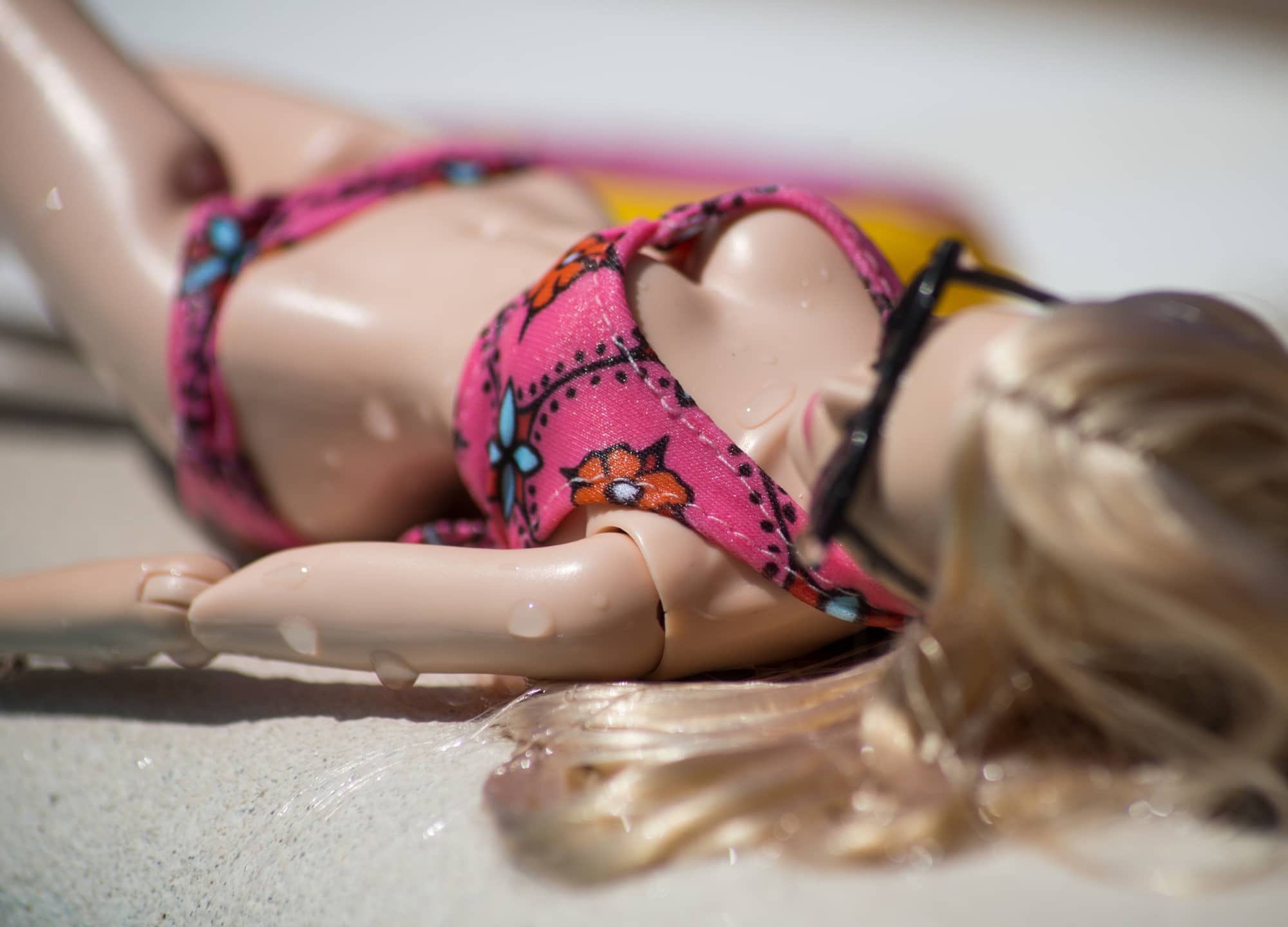You’re not imagining things—the color pink is everywhere this season, and we have the hotly anticipated premiere of Greta Gerwig’s Barbie movie to thank for that. Since the doll’s debut in the late ’50s, she’s been a staple of many childhoods as well as the first beauty ideal—which, ultimately, is pretty harmful. If Barbie were an actual person, she would stand at 5’9” and weigh 110 pounds, putting her at a BMI of 16.24 (which classifies as anorexia of moderate severity, according to one study), with measurements of 39-18-33.
Thankfully, Mattel gave Barbie a makeover in 2016, offering the doll in new curvy, tall, and petite iterations. Though this was likely in large part due to declining sales (from 2012 to 2014 alone, they fell 20%), it also happened to coincide perfectly with the body positivity movement. But now, with the body-baring styles of the ’90s and the incessant chatter about Ozempic, Barbie plastic surgery—which has always existed but was more fringe—could surge in popularity too.
Though you’ll see the Barbie look all over North America, Barbie plastic surgery has been especially popular abroad. 90 Day Fiancé stars Darcey and Stacey Silva shared that they headed back to Turkey for “Barbie touch-up surgery,” which included a breast lift and implants. Australian nurse and Botched star Tara Jayne McConachy, who is banned from undergoing plastic surgery procedures in her home country, has spent hundreds of thousands of dollars in the pursuit of her self-proclaimed “plastic doll vibe.” Her journey has included five breast augmentations, six nose jobs, butt implants, and frequent filler injections. She is also considering rib removal and a variety of eye procedures, including one to make her eye color a more vivid shade of green. And the most notorious “human doll,” Jessica Alves, has spent more than $1,000,000 to transform their look into Barbie’s boyfriend, Ken; since undergoing gender confirmation surgery, she is now known as “human Barbie.” She’s had more than 100 procedures to get her desired look.
Some less invasive treatments performed to get the Barbie look include fillers, for fuller lips and high cheekbones; fillers or fat along the jawline, for more definition; veneers, for flawless teeth; and laser skin resurfacing. “Barbie has perfect skin,” points out Dr. Melissa Doft, a board-certified plastic surgeon in New York City. But standard risks of plastic surgery aside, the dream of looking like Barbie can get pretty dangerous, depending on how extreme the desired outcome is. Here, we outline some of the riskier Barbie makeover procedures, the consequences, and why a thorough consultation—including one of a patient’s mental health—is critical.
Barbie noses
You may recognize the Barbie nose from Instagram—there’s a wide range of influencers sporting the buttonlike sniffer. “The goal of standard rhinoplasty is to maintain or improve nasal breathing and enhance the external appearance of the nose while keeping in harmony with the rest of the facial features,” explains Dr. Nigar N. Ahmedli, a board-certified otolaryngologist in New York City. Not so with a Barbie nose, which creates a short, upturned nose with a significantly reduced bridge. “In performing a Barbie nose, the surgeon needs to remove a fair amount of cartilage,” says Dr. Doft. “When too much cartilage is removed, the structure of the nose is weakened—which can lead to breathing difficulties, collapse, and a poor cosmetic result.”
Because the Barbie nose is very small, it also won’t suit the majority of faces, creating an imbalanced look. “When this nose is placed onto a face that has bolder features, such as large eyes or full lips, the face may look like a jigsaw that does not quite fit,” says Dr. Ahmedli. However, for those hoping to replicate Barbie’s face on their own, that may be the goal—so while it may not look strange to them, it may give off the “uncanny valley” effect to others. Dr. Oren Tepper, a board-certified plastic surgeon in New York City, notes that he has a few dozen patients come to his office each year, hoping for a similar drastic change to their noses; he highly values the use of 3D imaging for these and other nose job patients. “It is a great checkpoint to see if my patients and I share the same aesthetic vision,” he explains. “During the consultation, I am able to show simulations of new noses with varying degrees of change.” If a patient chooses simulated noses that fall in the overdone Barbie-esque category, he tells them that he’s not the right surgeon to help them achieve their goal.
Barbie breasts and waists
Barbie’s known for her lean curves; breast augmentation and liposuction are common procedures for anyone looking for Barbie’s shape (or a more enhanced shape, period—they’re two of the most prevalent plastic surgeries out there). These procedures are largely safe when performed by a skilled provider, but if a patient wants a more extreme look for their Barbie plastic surgery, there are risks. “When getting breast implants, it’s very important to not get a wider implant than the breast footprint,” says Dr. Joseph Zakhary, a board-certified plastic surgeon in Phoenix. Large implants can also result in “bottoming out,” which means the implant lies at the bottom of the breast, stretching the skin and even shifting the nipple to sit too high on the breast. “The higher ratio of implant to breast tissue puts you at increased risk of these complications over time,” he adds.
It’s rib removal, another curve-creating procedure, that makes for greater risk in the landscape of Barbie plastic surgery. “It’s not a common procedure in the United States,” says Dr. Doft. “It is not something that I would recommend.” It’s performed by making two incisions on either side of the spine and removing the lower ribs; while the lower two pairs of ribs “float” and are not connected to the sternum, they still help protect vital organs, including the liver and spleen. Likelihood of complications increases the more ribs that are removed, and generally speaking, any form of rib removal could lead to a collapsed lung.
Barbie labiaplasty
Perhaps the most concerning procedure is the Barbie doll labiaplasty. Most labiaplasties consist of trimming the labia minora so they doesn’t protrude past the labia majora, but this one goes one step further. “A Barbie labiaplasty is when all of the labia minora are removed except for some of the tissue covering the clitoris,” says Dr. Doft. While removing some of the labia minora can lead to a sleeker aesthetic and prevent them from getting caught on clothing or getting irritated, “removing all of the labia minora potentially will lead to painful scarring and painful sexual intercourse and is just not necessary,” Dr. Doft explains. A botched Barbie labiaplasty can cause chronic pain, bacterial infection, and a mutilated look.
Barbie feet
We’d be remiss to leave out one of Barbie’s most iconic features—her perpetually flexed foot, the appearance of which in the Barbie trailer caused a viral TikTok trend replicating the look. “Stepping out of heels into ‘Barbie foot’ as a social media challenge to repeat that scene is simply fun,” says Dr. Emily Splichal, a doctor of podiatric medicine and human movement specialist in Chandler, Arizona. The good news is that it’s safe too. “This position is called a ‘rigid lever’ of the foot, and we pass through this foot position every time we take a step,” she says.
It’s far riskier to wear ultra-high heels, as it strains the knees and lower back. “Posturally, when we go into an ultra-high heel, our pelvis and ribcage have to shift to prevent us from falling over in gravity,” explains Dr. Splichal. “As a result, the pelvis will roll forward, arching the lower back, and the chest will push forward, straining the neck.” She recommends limiting high-heel wear, restricting yourself to heels under three inches, and always releasing the feet once you kick off your shoes. You can do this by massaging the bottom of your heels with a golf ball, stretching the calves and hip flexors, and putting on toe spacers.
Ken doll plastic surgery
It’s not just Barbie who inspires plastic surgery or extreme looks—Ken’s appearance inspires men to masculinize their bodies and faces (remember, before Jessica Alves was human Barbie, she was human Ken). A common surgical option includes implants to make biceps, shoulders, and pecs pop, though these can be risky procedures, especially when performed by an unskilled provider. The implants are solid, so they can’t leak like breast implants can, but it’s possible for them to shift, cause nerve damage, or create asymmetry. “Some surgeons suggest using fat instead of an implant,” adds Dr. Doft.
You can also enhance the jawline with implants in the chin and at the corners of your jaw, near the masseter. The former are pretty popular and regarded as safe, but mandible angle implants are less so. “This is because after implantation, they are more prone to movement and displacement from their original position,” warns Dr. Ahmedli. When you open and close your mouth, your jaw muscles can displace the implants.
Another permanent procedure (with a far more painful and time-consuming recovery) is orthognathic surgery like genioplasty, which involves cutting and repositioning the jawbone to make the chin and jaw appear stronger. This can also be combined with a chin implant and other treatments, like neck lifts or submental liposuction, to create even more facial harmony. But before committing to such permanent measures, you can always try injectables. “A temporary way to enhance the size and definition of the jaw is the use of fillers injected over the chin and along the jawline,” says Dr. Ahmedli. “This typically lasts from six months to a year and can be altered to create a more or less defined look.” There’s also “mewing,” an at-home technique popularized on social media designed to bulk up the masseter, but it’s worth noting that this method has not been clinically proven—and the provider who came up with it, Dr. John Mew, was stripped of his dental license.
Barbie makeovers: an unfortunate reflection of society’s values
“Plastic surgery needs to be tailored to the needs and goals of individual patients,” says Dr. Doft. “As surgeons, we can find inspiration in Barbie, just as we find inspiration in art and from models, but it is only inspiration—not a technical guide.” You’ll get the best results from a procedure that enhances your natural beauty and creates classically beautiful proportions rather than creating a whole new look.
This is what makes the mental health component of a plastic surgery consultation so critical. “It’s extremely important during patient interviews to identify body dysmorphia and identify the patient’s primary motivations for aesthetic surgery,” says Dr. Zakhary, who cites many reasons for this, including the durability of the procedure and the satisfaction of the patient. For example, extra large breast implants won’t hold up the same way more naturally sized ones will, and a particularly bodacious BBL may not appeal to you years later. “Even though Barbie is all plastic, her aesthetic is very natural,” points out Dr. Zakhary. “When we hear ‘Barbie makeover,’ the idea is to go plastic, but the irony is that Barbie always evolved to look more and more like us.”
Dr. Doft agrees, reminding us of Barbie’s new body types and shapes, which help young girls accept their own and understand there’s no one “perfect” body. “With that said, society still covets height, a thin, athletic body, high, shapely breasts, a defined waistline, a sculpted jaw, and a small nose,” says Dr. Doft. “Perhaps we should not be blaming Barbie, as she is just a reflection of our own society’s desires.”











